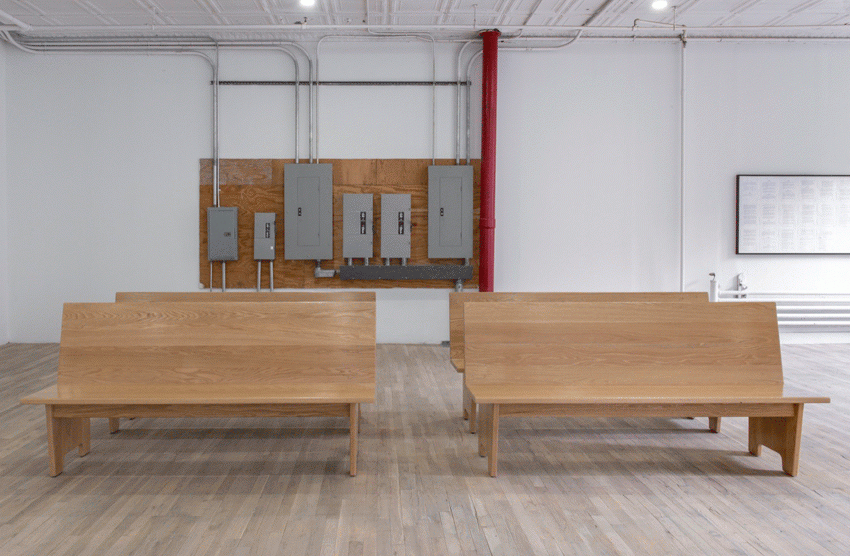Cameron Rowland’s sculptures unfold as unflinchingly direct manifestations of his in-depth research into the structural conditions that underwrite political and social realities. In person, a conversation will mercurially leap from landmark court rulings to neoliberal financial products to the formation of corporate conglomerations. The work itself is unapologetic in its minimalistic presentation of objects – often found –from a specific nexus of social and economic relations. The caption for Loot (2014), a plastic crate housing copper pipes, locates these items as the material traces of the transition of public utilities from state ownership to privatisation, going on to detail the pipes’ theft and resale as scrap metal – at which point Rowland isolated and inserted them into an art context and into a new reading. Removed from banal daily encounters, these objects – such as Pass-Thru (2014), for which Cameron constructed a bullet-proof box modelled on those used to protect transactions of money and goods at a bank or shop – become totemic markers of complex webs of control, exploitation and capital. These almost indexical or evidentiary assemblages sidestep sentiment while challenging the viewer to reassess the stuff that surrounds us as material evidence attesting to the function of power.
91020000, his widely lauded solo exhibition at Artists Space in New York last year, was a gut-punch confrontation of the prison-industrial complex in the US that implicated the show’s institution in the very processes he sought to critique. ‘91020000’ was the number assigned to Artists Space upon registering as customers of Corcraft, a supplier of various items made with prison labour (and operated by the New York State Department of Correctional Services), from whom the exhibited objects were bought. Featuring objects fabricated by inmates – variously desks, benches and protective suits (worn by inmate firefighters, also unpaid) – the exhibition rejects metaphor and symbolism, instead allowing the objects themselves to bear witness to the labour that produced them. That this labour was unpaid and forced upon largely black, incarcerated subjects makes a powerful statement on the extension of economic and social subjugation linking America today with its slaving past. In this Cameron draws on critical race theory, a theoretical framework that positions the continuation of racial power under US law. Through incisively bringing to light the conditions of labour through which the penal system economically benefits, Rowland exposes narratives of justice and liberty, central to American society, to be constantly co-opted and collapsed.
In a recent conversation, Rowland and I discussed his investigations of social impact bonds, a financial product pioneered in the UK and now an active in the US, which are offered by both governments to encourage private investment in public services (such as rehabilitation). The subject extends Rowland’s examination of the public realm’s contamination by the forces of unbridled capital, and in the Trump era – which we can speculate will accelerate privatisation and has already flared racial prejudice – Rowland’s works possess an even greater urgency and potency.
Full artist’s captions for images:
(1) Courtrooms throughout New York State use benches built by prisoners in Green Haven Correctional Facility. The court reproduces itself materially through the labour of those it sentences. Rental at cost: Artworks indicated as ‘Rental at cost’ are not sold. Each of these artworks may be rented for 5 years for the total cost of the Corcraft products that constitute it.
(2) The Attica Series Desk is manufactured by prisoners in Attica Correctional Facility. Prisoners seized control of the D-Yard in Attica from 9–13 September 1971. Following the inmates’ immediate demands for amnesty, the first in their list of practical proposals was to extend the enforcement “the New York State minimum wage law to prison industries.” Inmates working in New York State prisons are currently paid $0.16 to $1.25 an hour. Inmates in Attica produce furniture for government offices throughout the state. This component of government administration depends on inmate labour. Rental at cost: Artworks indicated as ‘Rental at cost’ are not sold. Each of these artworks may be rented for 5 years for the total cost of the Corcraft products that constitute it.
Rowland is based in New York. He has solo exhibitions at Galerie Buchholz, Cologne, and Établissement d’en face, Brussels, this spring and his work will be included in the Whitney Biennial, opening 17 March.
From the January & February 2017 issue, in association with K11 Art Foundation
